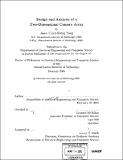Design and analysis of a two-dimensional camera array
Author(s)
Yang, Jason C. (Jason Chieh-Sheng), 1977-
DownloadFull printable version (21.94Mb)
Other Contributors
Massachusetts Institute of Technology. Dept. of Electrical Engineering and Computer Science.
Advisor
Leonard McMillan.
Terms of use
Metadata
Show full item recordAbstract
I present the design and analysis of a two-dimensional camera array for virtual studio applications. It is possible to substitute conventional cameras and motion control devices with a real-time, light field camera array. I discuss a variety of camera architectures and describe a prototype system based on the "finite-viewpoints" design that allows multiple viewers to navigate virtual cameras in a dynamically changing light field captured in real time. The light field camera consists of 64 commodity video cameras connected to off-the-shelf computers. I employ a distributed rendering algorithm that overcomes the data bandwidth problems inherent in capturing light fields by selectively transmitting only those portions of the video streams that contribute to the desired virtual view. I also quantify the capabilities of a virtual camera rendered from a camera array in terms of the range of motion, range of rotation, and effective resolution. I compare these results to other configurations. From this analysis I provide a method for camera array designers to select and configure cameras to meet desired specifications. I demonstrate the system and the conclusions of the analysis with a number of examples that exploit dynamic light fields.
Description
Thesis (Ph. D.)--Massachusetts Institute of Technology, Dept. of Electrical Engineering and Computer Science, 2005. Includes bibliographical references (p. 153-158).
Date issued
2005Department
Massachusetts Institute of Technology. Department of Electrical Engineering and Computer SciencePublisher
Massachusetts Institute of Technology
Keywords
Electrical Engineering and Computer Science.